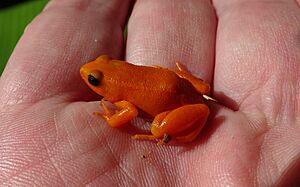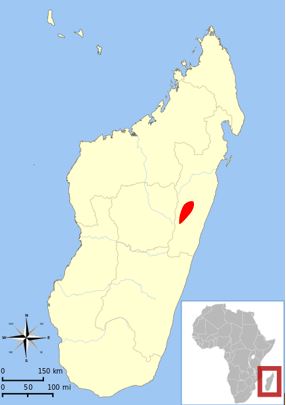Golden mantella facts for kids
Quick facts for kids Golden mantella |
|
|---|---|
 |
|
| Golden form | |
 |
|
| Red form | |
| Conservation status | |
| Scientific classification | |
 |
|
| Distribution of the golden mantella in Madagascar |
The golden mantella (Mantella aurantiaca) is a small, bright frog that lives only on land. It is found only in Madagascar, which means it is endemic there. This special frog lives in just a few small areas around the town of Moramanga. These areas include Beparasy, Ambohibary, the Torotorofotsy Wetland, and Ambakoana.
The golden mantella is one of Madagascar's most endangered amphibian species. This is because it lives in a very small area. This area is also facing many threats from human activities. The frog might also be in danger because too many are collected for the pet trade.
Contents
What Does the Golden Mantella Look Like?
The golden mantella is a small frog, usually 20–26 mm long. That's about the size of a large paperclip! It can be bright yellow, orange, or red all over. If you look at its inner legs, you might see red flash marks.
The frog has a small eardrum that you can see. Its bright skin colors are a warning to predators. This is called aposematism. It tells other animals that the frog is poisonous and not good to eat.
Golden Mantella Life and Habits
The golden mantella changes its behavior a lot with the seasons. During the cooler winter months, from May to October, it stays mostly hidden. But in the summer, when it's warmer, these frogs are often active during the day.
They usually live in groups. In these groups, there are often twice as many males as females.
Reproduction and Life Cycle
When the rainy season starts and the weather gets warm, the frogs come out of hiding. They use small, still wetlands for breeding. Male frogs often call from hidden spots near water. Their call sounds like a pleasant, repeated click.
Golden mantellas do not mate in the usual frog way. The male just moves over the female's back. The eggs are laid on land in damp leaf litter close to water. When it rains, the tiny tadpoles are washed from the land into the water.
What Do Golden Mantellas Eat?
The golden mantella eats small invertebrates. In the wild, they mostly eat mites, ants, flies, and tiny insects called collembolans. These frogs get their skin poisons from the food they eat. These poisons include special chemicals like pumiliotoxin and pyrrolizidines.
Even though they are poisonous, some animals still eat them. A snake called Thamnosophis lateralis and a skink (a type of lizard) from the genus Zonosaurus have been seen eating golden mantellas.
Golden Mantellas in Captivity
There are plans to start a legal program to collect these frogs. This would allow some frogs to be taken from the wild in a controlled way.
A study in 2017 showed that golden mantellas raised in captivity react faster than those in the wild. This means captive frogs might be quicker to respond to things around them.
Sometimes, golden mantellas are kept as pets by collectors or in zoos. People like them because they are active during the day and have beautiful colors. They are also fairly easy to care for once they get used to a new home. You can easily find guides on how to care for them. However, it's important to remember that the golden mantella is critically endangered, and its population is shrinking.
How Golden Mantellas Are Classified
Naming the Golden Mantella
The French scientist François Mocquard first described this species in 1900. He found a male frog that was 21.2 mm long. This frog was found in forests between Beforana and Moramanga. The name aurantiaca comes from a Latin word meaning "gold," which describes the frog's color.
There was also a name for a red type of this frog, M. a. rubra. But scientists later found that it was the same species as the golden mantella. The name rubra comes from the Latin word for "red."
Convergent Evolution: Similar Paths
Convergent evolution is when different species in different places develop similar traits. The golden mantella evolved in Madagascar. But it shares many of the same ways of adapting as poisonous frogs in Central and South America. These frogs belong to the Dendrobatidae family.
For example, both the golden mantella and the Dendrobatidae frogs can get poisons from their food. They also both have bright warning colors. And they have similar ways of reproducing. This shows how different animals can evolve in very similar ways when they face similar environments.


